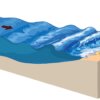A hurricane or typhoon is a severe weather event with wind and rain that can cause extensive damage and flooding both inland and on the coastlines.
Hurricanes /Typhoons
Such an event, sometimes called a tropical cyclone, is a system with sustained winds of at least 34 metres per second (66 kn) or 74 miles per hour (119 km/h) characterized by a low-pressure centre, a closed low-level atmospheric circulation, strong winds, and a spiral arrangement of thunderstorms that produce heavy rain.
Sufficiently warm sea surface temperatures are considered vital to the development of tropical cyclones, and maybe related to overall climate change.
Preparing for storms
While the dredging industry cannot single-handedly prepare for severe weather events, many ideas have been formulated to construct land reclamations and coastal management schemes to minimise destruction of life and property.
These include some of the projects implemented using the principles of Building, Engineering and Working with Nature, as well as other sustainable techniques, for instance the preservation of wetlands and mangroves that hold the soil even during hurricanes and typhoons. Elaborate seawall defences and the construction of storm-surge barriers can also help to regulate the surges created by these storms which result in enormous flooding and loss of life and property.
Tidal areas against severe flooding
With climate change causing an increase in the number and severity of hurricanes and typhoons, the dredging industry has been taking active steps to find solutions that offer sustainable solutions. This requires long-term planning such as the Delta Plan in the Netherlands and the Sigma Plan in Belgium. Both of these are master plans that use dredging techniques to protect tidal areas against extreme floods.












